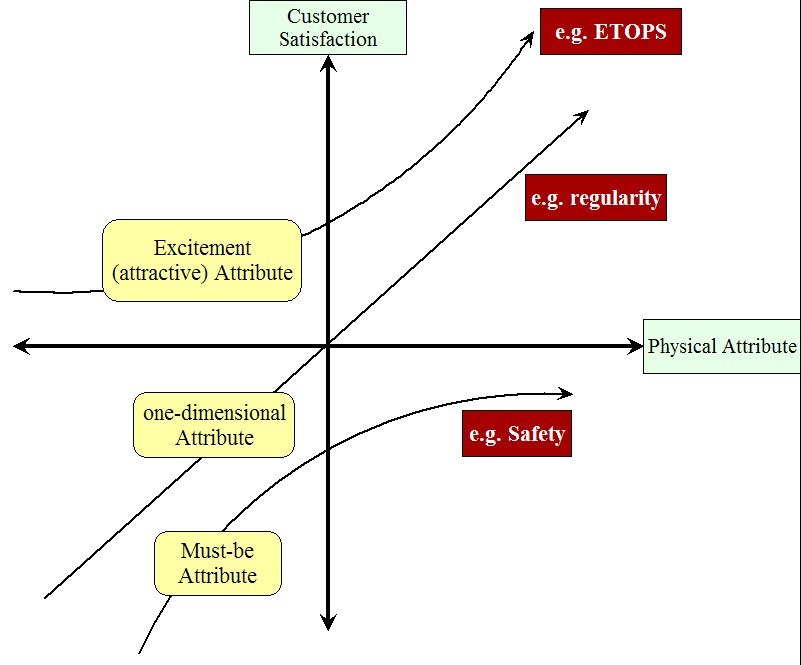Kano Analysis
Kano analysis aims to differentiate potential customer satisfaction from a product, service or process feature into:
- Must-be

- One dimensional
- Attractive
- Indifferent
- Reverse
Kano analysis achieves this through customer answers to pairs of survey questions:
- (positive, functional question) How would you respond if this feature were in the product, service or process?
- (negative, disfunctional question) How would you respond if this feature were not in the product, service or process?
Example
(A vacuum cleaner)
Positive question : If the vacuum cleaner has an electric cable reel (instead of a manual reel), how would you feel about the cleaner?
Negative question : If the vacuum cleaner did not have an electric cable reel (instead of a manual reel), how would you feel about the cleaner?
- It must be that way
- I like it that way
- I am neutral
- I can live with it that way
- I dislike it that way
Analysis
Survey answers are counted as pair-responses. A matrix shows how each pair response corresponds to a satisfaction category.
|
Functional question |
Disfunctional question |
||||
|
(1) Must be |
(2) Like |
(3) Neutral |
(4) Live with |
(5) Dislike |
|
| (1) Must be |
Q |
A |
A |
A |
O |
|
(2) Like |
R |
I |
I |
I |
M |
|
(3) Neutral |
R |
I |
I |
I |
M |
|
(4) Live with |
R |
I |
I |
I |
M |
|
(5) Dislike |
R |
R |
R |
R |
Q |
|
Note: A: attractive; M: must be; O: one dimensional; Q: questionable; R: reverse |
|||||
For example:
|
Product Requirement: Electric Cable Reel |
Percentage of replies |
|||||||
|
A |
O |
M |
I |
R |
Q |
Total |
Category |
|
|
53.9 |
28.2 |
7.4 |
8.4 |
0.3 |
1.8 |
100 |
A |
|
| Extent of satisfaction = |  |
| Extent of dissatisfaction = |  |
Interpretation of results
The positive CS-coefficient ranges from 0 to 1; the closer the value is to 1, the higher the influence the feature would have on customer satisfaction. (Example: 0.82)
For negative CS-coefficient, if it approaches -1, the influence on customer dissatisfaction would be especially strong if the analysed product feature were not fulfilled. (Example: -0.36)
Example Summary
The presence of an electric cable reel on a new vacuum cleaner (instead of a manual reel) would lead to more than proportional satisfaction.
It is an attractive feature.
Application References
"Capturing the customer’s voice, the centerpiece of strategy making", S.K. Bhattacharyya; Zillur Rahman, European Business Review, Vol. 16 No. 2, 2004, pp. 128-138
"Citizens' Role in Health Services: Satisfaction Behaviour: Kano's Model, Part 1", Antoni Corbella Jane, Salvador Maturana Dominguez. Quality Management in Health Care. Frederick: Jan-Mar 2003. Vol. 12, Iss. 1; p. 64
"Citizens' Role in Health Services: Satisfaction Behaviour: Kano's Model, Part 2", Antoni Corbella Jane, Salvador Maturana Dominguez. Quality Management in Health Care. Frederick: Jan-Mar 2003. Vol. 12, Iss. 1; p. 72
